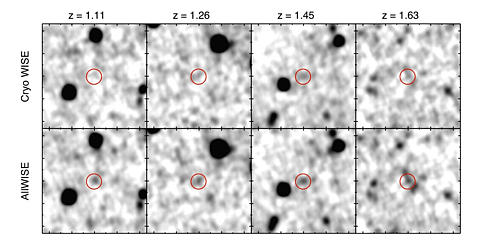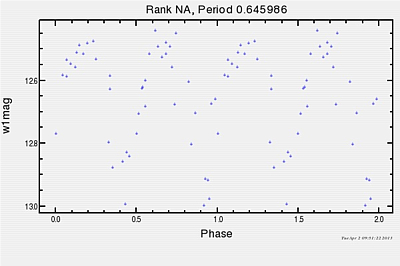 |
| Figure 1 - A comparison of 1x1 arcminute cutouts of AllWISE (bottom row) and WISE All-Sky (top row; labeled "Cryo WISE") W2 band Atlas images of four z>1 galaxies in the COSMOS field. |


The AllWISE program extends the work of the successful Wide-field Infrared Survey Explorer mission (WISE; Wright et al. 2010, AJ, 140, 1868) by combining data from the cryogenic and post-cryogenic survey phases to form the most comprehensive view of the mid-infrared sky currently available. AllWISE has produced a new Source Catalog and Image Atlas with enhanced sensitivity and accuracy compared with earlier WISE data releases. Advanced data processing for AllWISE exploits the two complete sky coverages to measure source motions for each Catalog source, and to compile a massive database of light curves for those objects.
WISE is a National Aeronautics and Space Administration (NASA) Medium Class Explorer mission that scanned the sky methodically in the 3.4, 4.6, 12 and 22 μm mid-infrared bandpasses (hereafter W1, W2, W3 and W4) in 2010 and 2011. The 40 cm WISE telescope and payload equipped with four 1024x1024 pixel focal plane detector arrays were cooled by a dual-stage solid hydrogen cryostat. WISE carried out its 4-Band (or Full) Cryogenic survey from 2010 January 7 to 2010 August 6, observing the sky 1.2 times with all four detectors operating at full sensitivity. After the hydrogen ice in the outer cryogen tank evaporated, WISE surveyed an additional 30% of the sky during its 3-Band Cryo phase, with the W1 and W2 detectors operating at near full sensitivity, and the W3 focal plane operating at reduced sensitivity. The NEOWISE Post-Cryo phase (Mainzer et al. 2011 ApJ, 731, 53), funded by the NASA Planetary Division, started on 2010 September 29 after cryogen in both tanks was exhausted, and continued until 2011 February 1. NEOWISE Post-Cryo observations covered 70% of the sky with W1 and W2 detectors operating at near full sensitivity. Images and extracted source data from each of the three survey phases were release separately in the March 2012 All-Sky Data Release, the June 2012 3-Band Cryo Data Release, and the May 2013 NEOWISE Post-Cryo Release.
The AllWISE release includes the following new data products.
Data from the WISE and NEOWISE missions have already enabled fundamental research in a startling variety of fields, ranging from the study of Near Earth Asteroids to distant, luminous galaxies and obscured AGN. With its increased sensitivity and time-domain information, AllWISE will complement and extend this already rich legacy, as well as open avenues of study that were not possible with the original mission data.
The Distant Universe - The added sensitivity of AllWISE realized from combining W1 and W2 data from all survey phases crosses a major threshold for luminous distant galaxies, where their apparent brightness at 4.6 μm (W2) no longer declines significantly with increasing redshift. The improved detectability of z>1 galaxies in the COSMOS field with AllWISE is illustrated in Figure 1. Detection of large samples distant AGN can be used to investigate large scale structure, and concentrations of them are signatures of massive galaxy clusters.
 |
| Figure 1 - A comparison of 1x1 arcminute cutouts of AllWISE (bottom row) and WISE All-Sky (top row; labeled "Cryo WISE") W2 band Atlas images of four z>1 galaxies in the COSMOS field. |
The Solar Neighborhood - AllWISE measurements of source motion using the 6- and sometimes 12-month baseline between the cryogenic and post-cryogenic survey measurements enable a search for nearby objects independent of color selections and for very high-motion objects overlooked in previous surveys. Figure 2 illustrates the proper motion over nearly 60 years for WISEA 07071961+1705464 (Wright et al. 2014), an ultra-subdwarf M star identified from its AllWISE measured motion. Other examples can be found in Kirkpatrick et al. (2014).
 |
| Figure 2 - Montage of 2x2 arcminute images from different epochs showing WISEA 07071961+1705464, which has a proper motion of 1793 mas/yr and that was discovered from the motions reported in the AllWISE Source Catalog. Click on the image to view an animation that shows a movie cycling through the different epoch images. |
Variable Source Studies - The data used for AllWISE cover a much larger range of timescales for variability studies than the data releases from the individual survey phases, opening up the possibility to characterize longer period variable stars and AGN. The AllWISE Multiepoch Photometry Database allows easy retrieval and analysis of light curves for all sources in the deep detection AllWISE Source Catalog. Figure 3 shows an example of a phased W1 band light curve generated from the AllWISE Multiepoch Photometry Database for WISEA J104603.43-524240.7, a previously unknown W UMa variable star that is identified as a flux variable in the AllWISE Catalog.
 |
| Figure 3 - Phased W1 light curve made from photometry in the AllWISE Multiepoch Photometry Database for a newly discovered W UMa variable, WISEA J104603.43-524240.7. |
AllWISE provides major advances in the sensitivity, accuracy and information content over the earlier WISE data releases. The AllWISE Catalog and Image Atlas supersede those from the earlier All-Sky and 3-Band Cryo Data Releases for most uses.
The WISE All-Sky Release Source Catalog may provide better photometric information for sources that are saturated in W1 and W2, and were observed during the Post-Cryo phase. In addition, position and flux measurements for fast moving solar system objects will be found only in the WISE All-Sky, 3-Band Cryo and NEOWISE Post-Cryo Release Single-exposure Source Databases. They will not be present in the AllWISE Multiepoch Photometry Database.
This Explanatory Supplement for the AllWISE Data Products contains a description of the content, format and properties of the AllWISE Source Catalog and Reject Table (II.1), Multiepoch Photometric Database (III.1), and Atlas Images (IV.1). A summary of the improvements made to the WISE Science Data System (WSDS) processing system that generated the AllWISE products is given in V.1.
Detailed descriptions of the WISE and NEOWISE programs, the WISE flight system and survey strategy, and the the WSDS processing system are available in the Explanatory Supplement to the WISE All-Sky Data Release Products. These detailed descriptions are not repeated in this document, but frequent links back to the All-Sky Release Explanatory Supplement are used to direct readers to the additional information.
The AllWISE program is funded by the NASA Science Mission Directorate Astrophysics Division and overseen by the NASA Explorer Office at Goddard Space Flight Center. Prof. Edward Wright of the University of California Los Angeles if the AllWISE Principal Investigator. AllWISE is managed by the Jet Propulsion Laboratory, California Institute of Technology. Data processing, archiving and distribution for AllWISE is carried out by the Infrared Processing and Analysis Center, California Institute of Technology.
AllWISE makes use of data from the WISE and NEOWISE programs that are funded by the NASA Astrophysics and Planetary Divisions, respectively. Please acknowledge these programs when using AllWISE image or source data products in your publications, as described in I.6.b.
AllWISE makes use of data from the Two Micron All-Sky Survey which is a joint project of the University of Massachusetts and the Infrared Processing and Analysis Center/California Institute of Technology, funded by the NASA and the National Science Foundation. AllWISE kindly acknowledges Norbert Zacharias for providing early access to and guidance for making the best use of the USNO CCD Astrographic Catalog (UCAC4).
Analyses in this document make use of observations made with the Spitzer Spitzer Space Telescope, obtained from the NASA/IPAC Infrared Science Archive, both of which are operated by the Jet Propulsion Laboratory, California Institute of Technology under a contract with NASA, and the Sloan Digital Sky Survey, which was funded by the Alfred P. Sloan Foundation, the U.S. Department of Energy, the Participating Institutions, the National Science Foundation, NASA, the Japanese Monbukagakusho, the Max Planck Society, and the Higher Education Funding Council of England.
Last update: 2 March 2019